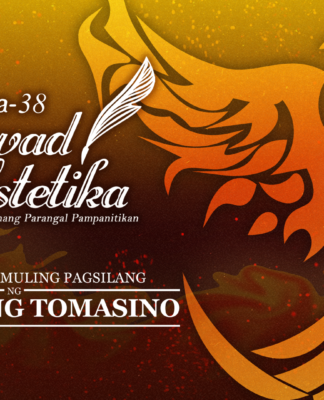THE Varsitarian is more than just your ordinary student paper.
Annually, the country’s forerunner of campus journalism gathers campus journalists nationwide, moves literary development in the campus, and promotes academic excellence.
In between deadlines, the Varsitarian staffers become program organizers, solicitors, props men, and technicians, to these activities, which are strong proofs of their multifaceted characters.
On its 74th anniversary, the Varsitarian reveals the other side, very few Thomasians have seen.
Inkblots, the UST National Campus Journalism Fellowship
When the rest of the University pack their bags for the semestral break, Varsitarian staffers stay put to prepare for Inkblots, the UST National Campus Journalism Fellowship.
Now on its third year, Inkblots is a three-day journalism fellowship composed of lectures/seminars and workshops on newswriting, sportswriting, feature writing, literary journalism, lifestyle and culture writing, entertainment writing, investigative reporting, Filipino journalism, and campus paper management.
Some of the past speakers included former Manila Times associate editor and Philippine Center for Investigative Journalism member, Chay Hofileña; Today editor in chief, Ma. Lourdes Molina Fernandez; Philippine Star sports columnist, Joaquin “Quinito” Henson; Tempo entertainment editor, Nestor Cuartero; and Philippine Daily Inquirer Assistant lifestyle editor and Varsitarian publications adviser, Joselito Zulueta.
Last year’s highlight was the First National Investigative Journalism Award (NCIJA), established by Washington-based legal editor and former Varsitarian editor in chief Julio Macaranas, Jr., in honor of his late mother, Mercedes Macaranas.
This year’s NCIJA proclaimed no winner. The judges were Manila Bulletin associate editor and UST Faculty of Arts and Letters Professor Ramon Francisco and Macaranas. However, the UST Journalism Society’s Angelo de Alban, Jose Guerero Mallari, and Leslie Van Venturanza were awarded Honorable Mention and received P10,000 for their investigative report about fake marriages in the Manila City Hall, published in the society’s newsletter, the Journalese.
Ustetika Annual Awards for Literature
The Ustetika season has always been a well-attended and supported campus activity, being the “Palanca” of the University.
The Awards started as the Annual Varsitarian Literary Awards. Later on, it was renamed Rector’s Literary Award in 1959. The almost infinite ember, however, died down during the proclamation of Martial Law. It was however restored in 1986 when Victor E. Carmelo Nadera, Jr., combined the words UST with estetika or aesthetics to create a new name for the contest.
One of the most awaited award given to writers is the Rector’s Literary Award (RLA), which was restored in 1991. The University Rector chooses from any of the entries, which won first place in the Ustetika and which exhibited the Catholic and humanistic vision of the University.
There is also, the Parangal Hagbong, a posthumous award given to Thomasian writers for their exemplary contribution to Philippine Literature.
Past recipients included National Artists Rolando Tinio and Rogelio Sicat, Genoveva Edroza-Matute, National Artist for Visual Arts J. Elizalde Navarro, Erma Cuizon, Reynaldo Duque, Ponciano Pineda, and last year’s Lilia Pablo Amansec.
The newest category, the Ustetika Essay Prize for High School, aimed to encourage students from the UST High School and the UST Education High School to participate in the University’s literary circle, was also launched during the 17th Ustetika.
Pautakan
Now on its 25th year, Pautakan, perhaps the longest-running campus quiz contest in the country, proved to be the Univesity’s barometer of intellectual excellence under pressure.
More than a prominent feature during the University week, Pautakan, promotes camaraderie among students and verifies the University’s strong pursuit of intellectual excellence.
In January 1977, the Varsitarian staffers thought of giving quiz bees a new name. They conceived a quiz contest that concerned more than the numbers on the score board. Thus, two years later, the name Pautakan was coined.
In the staffers’ desire to give the contest the most proper name, the contest underwent two name changes, one in 1980 when it was called, “Annual Intercollegiate Quiz Contest” and in 1981 when it was termed, “Brainstorm.”
But the following year, the contest was given back its original name. Since then, Pautakan had not only epitomized the Thomasian pursuit of intellectual excellence but also the promotion of camaraderie among students.
However, the flourishing tradition came to a halt in 1986 when the country stood witness to the battle for democracy during the Edsa People Power I.
In 1992, a new contest format was adopted and the new design of the Pautakan trophy by then art editor Rommel Lugada was introduced. The system, the team that wins three championships will take home the trophy.
It was in the year 2000 that the Varsitarian introduced the buzzer system, breaking away from the pen-and-acetate format. The new format was initially earned opposition from the contestants, but the innovation later on proved to be more efficient and added more life to the competition.
With these extra-editorial activities, the Varsitarian lives up to its long tradition of excellence and proves that its staffers can work well Thomasian community and to the national campus journalism scene as it nears its diamond jubilee next year.
















im a freshie !
and im just wondering if i can join the school publication..
are there any try-outs?!